Have you wanted to use the older form of the office, the Roman Breviary, but haven’t been able to do it because your Latin isn’t strong enough or you couldn’t figure out how to do it?
You are in luck.
Today I received from the nice people at Baronius Press the new set of the three volume Roman Breviary, Latin and English translation in side by side columns.
I think they cost $400. Click HERE.
There are accompanying cards, printed on card stock, which have commonly used prayers either during the day or at certain times of the year.
They seem pretty durable, though I may laminate to be sure.
One of those items, by the way, is a small booklet with common prayers for the day, canticles and so forth.
The title of this book, which came with the set, is self-explanatory.
Each volume has a slip cover.
The front is stamped, but this is not embossed.
 I like the way Baronius Press handles their leather covers. Their Extraordinary Form hand missal is done this way too.
I like the way Baronius Press handles their leather covers. Their Extraordinary Form hand missal is done this way too.
The paper, endpaper, makes a difference in a book you look at several times a day every day! It better be nice! This is.
General page layout and two of the six ribbons.
There are explanatory, interpretive notes in English along the way.
The colors of the ribbons.
The book lies open pretty well just out of the box, except when open to a page near the beginning or end. That is to be expected. The bind will loosen up.
The great Bishop Bruskewitz is the culprit! WDTPRS kudos to Bp. B!
There is a good explanation of the genesis of the set.
Beautiful books, reminiscent of a better age of liturgical books.
From the Baronius Press website comes this list of the features
A new edition of the Roman Breviary 1961 in English and Latin. An invaluable set of books for all those attached to the traditional Roman Breviary, in the form approved by Pope Benedict XVI in Summorum Pontificum.
Summary of features:
- 6,064 pages printed in black and red, text of all hours in Latin and English with rubrics in English.
- Concordat cum orginali [sic] – meaning the Latin text is approved by the Church for liturgical use, Imprimatur and foreword from Bishop Fabian Bruskewitz STD of Lincoln.
- [NB] Based on the popular three-volume Breviary published by Collegeville in 1963.
- St. Jerome’s traditional Gallican Psalter from the Vulgate is used throughout. [Not the Pius XII psalter.]
- English version of Psalms thoroughly revised to match the Gallican Psalter.
- Follows rubrics promulgated by Blessed Pope John XXIII – the form of the traditional Breviary approved in Pope Benedict XVI’s Summorum Pontificum.
- Scriptural texts in English follow the Confraternity translation (a 1940s revision of Challoner’s Douai-Rheims Bible), which have been revised where necessary to conform to the Vulgate text.
- Contains Penitential Psalms and the Office for the Dead.
- Full texts of national feasts for the USA included in the Proper of Saints. National feasts for England & Wales, Scotland and Australasia indicated in the Proper on the dates they occur.
- English versions of hymns in the acclaimed translation of the Rev. Joseph Connelly.
- Thirty engravings throughout, which have been selected from traditional liturgical books, carefully scanned, and re-mastered – correcting any defects in images where necessary.
- Extracts from the Rituale Romanum (including the most commonly used litanies) given in Latin with English rubrics in an Appendix.
- Full text of relevant motu proprio (Pope John XXIII’s Rubricarum Instructum and Pope Benedict’s Summorum Pontificum) in Latin and English.
- Thirteen Cards with commonly used prayers in Latin and English.
- All texts of the Cards also gathered in a handy booklet – in addition to being on the cards.
- Booklet containing common texts and basic instructions for praying for the Day Hours of the Breviary. Both booklets are sized to conveniently fit at the back of each volume.
- A free copy of Learning the Traditional Breviary is included with all orders.
- Flexible cover, leather bound with edge stitching for extra durability.
- Printed on light cream Bible paper. [Nice paper, btw.]
- Beautifully printed endpapers
- Gold gilt page edges and rounded corners.
- Six soft ribbons.
- Slipcase provided for each volume for additional protection
Did you know that Sacrosanctum Concilium says that those who are bound to say the office must do it in Latin?
I just toss that in because that FACT is interesting.
This set of the reworked “Collegeville” breviaries could be a huge help to someone whose Latin isn’t that strong, or who doesn’t want to fight with some of the harder bits during Matins, etc.
Click HERE.

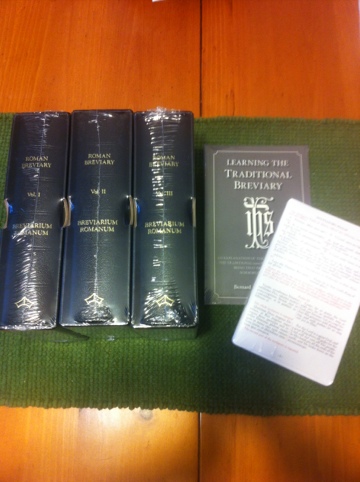
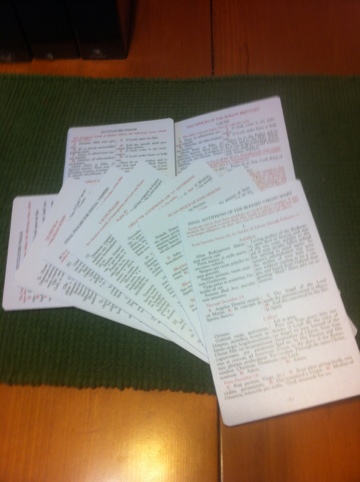
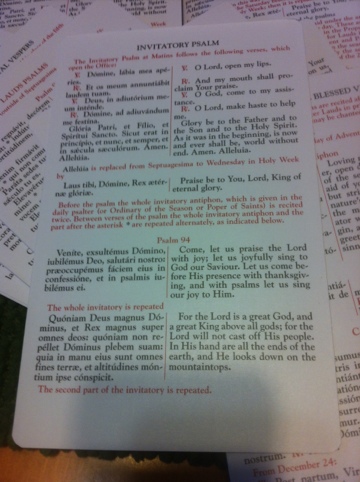
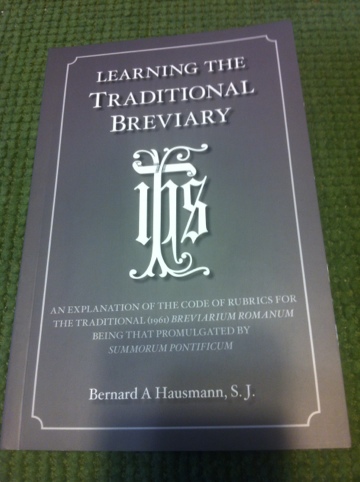
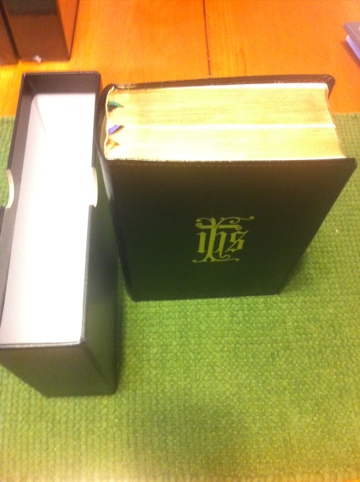
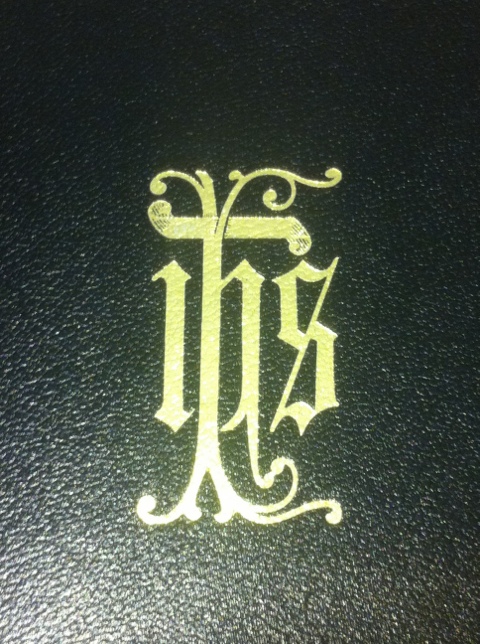


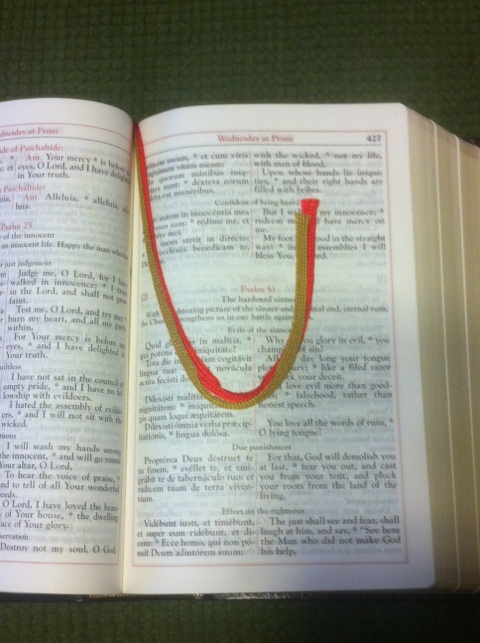
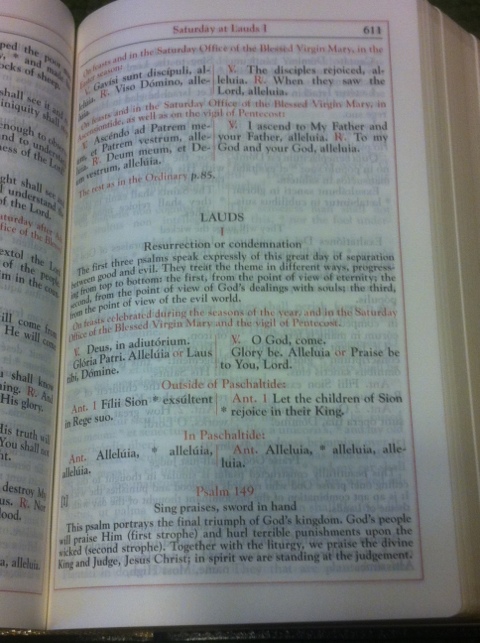
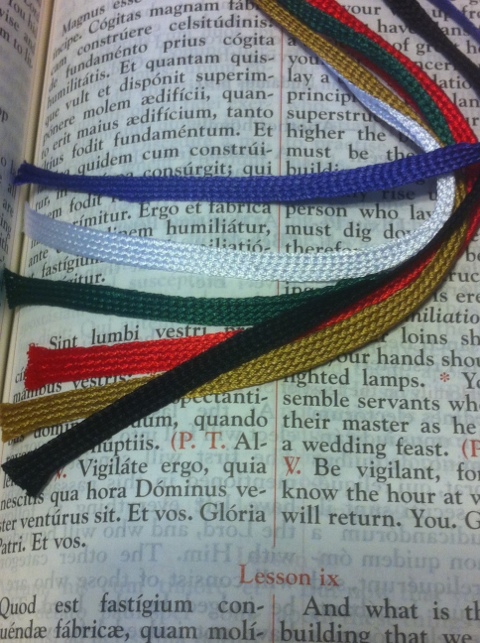
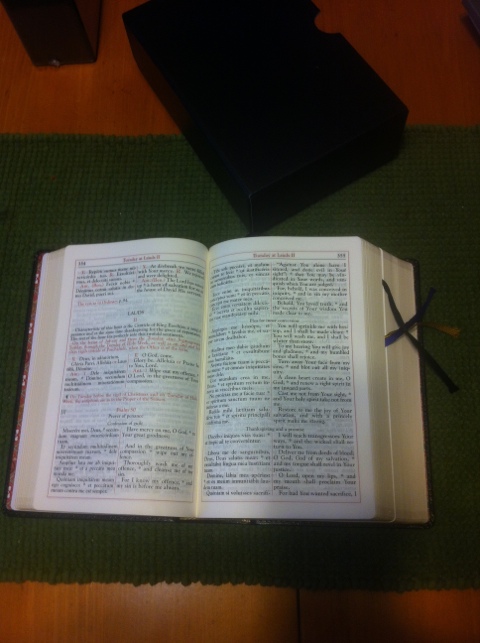
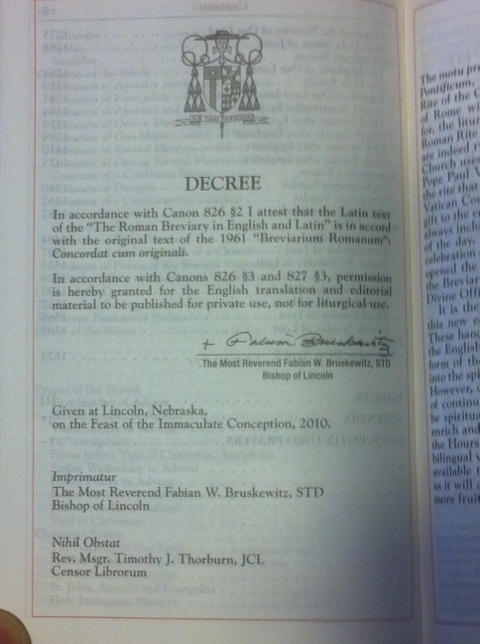
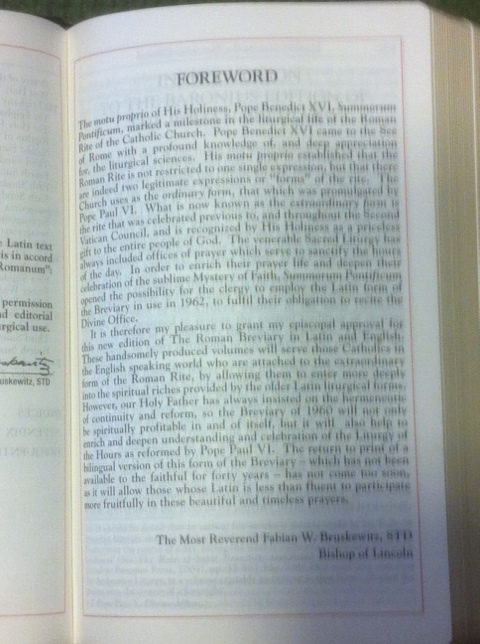
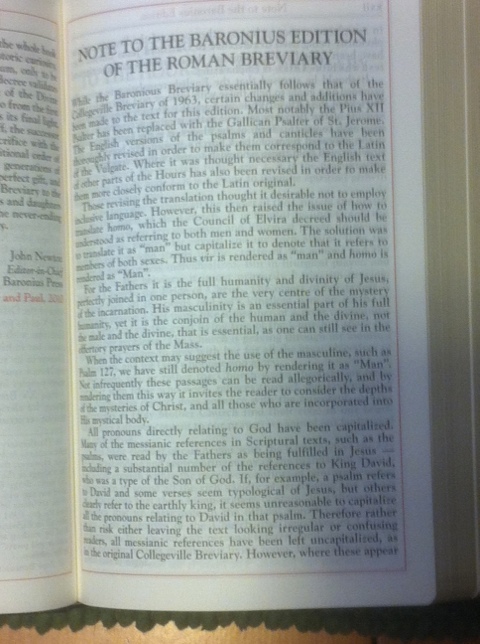

































Well now it sounds like it is come out very well! I wish I could afford to give a gift like this to a priest or two I know! :)
@Shin
Perhaps it might show up for sale on eBay. That’s where I got my Baronius Press hand missal from for $45 new when every other Canadian retailer was selling it for $100+ excluding taxes and shipping and handling
I use an original Collegeville edition breviary, and if the card stock is the same, Father, they will hold up fine without lamination. Mine are still going strong with daily use for the last 7 years that I have had it, anyway.
I am glad this is finally available. Now, I can retire my original set, and use a newer set without that ever niggling thought at the back of my mind that I am using an antique book instead of preserving it. lol
Did you know that Sacrosanctum Concilium says that those who are bound to say the office must do it in Latin?
I just toss that in because that FACT is interesting.
Yes but that FACT is no longer operative [except in the EF] because of subsequent liturgical law
I am graduating with my MA in Theology in May. This would make a wonderful graduation gift as I now say the breviary on my ipad. Just sayin’.
Over $100 per volume? This seems ludicrously expensive….I wonder how much our printsites could do it for [If you use the set for 25 years, it works out to less than $0.04 per day.]
This breviary is not “out of stock” in the usual sense. This first printing has not yet ever been in stock. I surmise something like this: That a few review copies like yours were shipped by air, but the bulk of copies for sale are on a slow boat in transit from . . . . the Philippines where they were printed, after delays due to various disasters including a typhoon.
$100 a volume? The new Liturgia Horarum [4 volumes] which is quite beautiful, but no pictures is more than double that per volume…but the bonus is you actually get readings from the Fathers! :-) [It sounds as if you are itching for a discussion about the merits of the office of Readings v traditional Matins.]
Been waiting for Baronius’ completion of this for some time but, alas, with the price must continue to wait. Will, nevertheless, commend their work VERY highly. As Fr Z points out, my missal from them costs less each Sunday.
Thanks for showing this Father! I’m waiting for my email but am afraid that I won’t get one for the first printing. It looks simply beautiful! I don’t however care for the second-rate ribbons they use, just like the ’62 Missal. I love the missal but don’t like the ribbons. I would need to either make a set for myself or buy a replacement premade set, but they won’t be set into the binding…. *SIGH*… againd thanks! The volumes look simply superlative!
$350 too expensive? I paid over $600 for my original set… $350 is very reasonable for a brand spanking new set of books that will last most of your life.
This set is beautiful, EXACTLY what I have been looking for and I’ve been on the pre-order alert list for some time now. Waiting may be a good exercise in patience but it still is not my strong suit. :P
I wish they would just take pre-orders so that when it gets in they can just charge my card and put my copy in the mail to me!!
They do such nice work on their books.
I have their EF hand missal and it is wonderful! This looks like similar quality and would be well worth the price; I’m going to start saving up for it :-)
I have a copy of the 3-volume Collegeville edition here at home. I got it off of eBay for a steal, something like $100.
I used it religiously (pun intended) for a few years, before migrating to the pre-1955 version of the Office via the Anglican Breviary (with some Latin inserts I made myself). The biggest downside of the 1960 Office is the destruction of Sunday Matins, and Matins readings in general.
Having basically already used this Baronius volume in its ancestral Collegeville form, I can tell you that it is quite user-friendly. The inserts serve as a very useful hedge against flipping back and forth, back and forth. You only really need five ribbons (Season, Ordinary, Psalter, Saint, Common). The sixth one can be used for any number of things, to say nothing of the inserts.
I also really like the font. It seems very serious somehow. I dunno. Maybe I’ve just seen too many bad modern liturgical books, and this seems like something out of the “Bells of St Mary’s” era of Catholicism by contrast.
I pray the Liturgy of the Hours daily, but looking at this makes me want to flirt with the idea of somehow incorporating the Divine Office in the Extraordinary Form into my daily prayer life…
I’ve been on the pre-order list for a while now.
But I’ll have to think about it, $350 is a bit much for us right now. While we could swing it, it’ll make things tight for a month or so.
Decisions, decisions.
@Geoffrey, as someone who did that exact thing, I would suggest you go SLOWLY. The LOTH is far, far shorter and less intensive than the traditional office. Think of how you felt when you first started wrapping your arms around the LOTH, and you begin to get the idea. Don’t gorge–eat slowly, even over several years.
I would start by swapping out Compline in order to get a feel for it. Then the Day Hours, which are (compared to LOTH) not an afterthought in the older Office. Then Lauds and Vespers. Then Prime, which is actually a nice thing to pair up with Lauds in the morning. Finally, and last of all because it is so alien to the LOTH, Matins.
You might also want to only do so on days where the calendars align at first, in order to get into that whole issue.
A final thing: keep in mind that Bl. Pope John XXIII suggested that people with busy morning schedules (or noctural people, like me) start the day with Lauds and end with Compline. Matins of the next day would be prayed between Vespers and Compline. The order would go:
Lauds, Prime, Terce, Sext, None, Vespers, Anticipated Matins, Compline.
Otherwise, if you can handle the crunch in the morning:
Matins, Lauds, Prime, Terce, Sext, None, Vespers, Compline.
Laity can of course do all this with freedom.
Do you have a pointer to a past discussion of “Office of Readings” versus “Traditional Matins”?
I am curious because I have been praying and reading the English Office of Readings for the last several years instead of Morning/Evening/Night prayer (the English version of “Traditional Matins”?) My motivation was to have a very well vetted scripture study guide that I, with my busy life as an engineer, had the time for. So far it has been wonderful, introducing me to several of the works of various early church fathers.
@ArtND76, here’s a quick list of the major differences between OOR and Matins:
1. OOR can be prayed at any time of the day, but Matins is the first hour of a day
2. Matins was usually anticipated the prior afternoon or evening, not so with OOR
3. OOR has three psalms, Matins has nine
4. The Invitiatory Psalm is always connected to Matins, as is “Lord, open my lips…”
5. OOR has a Biblical and a non-Biblical reading. Matins can have three Biblical readings, two Biblical readings and a non-Biblical reading, or three non-Biblical readings following a Gospel incipit. In the 1960 Breviary, on major feasts there were actually nine readings (three Biblical, three non-Biblical biographical, three non-Biblical homiletic)
6. The “Te Deum” is said much more often in Matins–after all saint days, and all Sundays outside of penitential seasons
If you are familiar with publishing today, these books are not that expensive by comparison. A single, nicely bound Bible goes for $150. They are also a once-in-a-lifetime investment. Fr. Z’s review is friendly and appreciated, but I would like to add a slightly more enthusiastic note. Baronius Press is a small outfit, and their production of this Breviary has been long and laborious, clearly motivated by love. The results look nothing short of a miracle — stunning, and an answer to prayers for a project that seemed an exercise in almost impossible over-reach. I doubt a lot of people *can* afford this as a random expenditure, but it really doesn’t fall in that category anyway. Baronius’ books are top of the line — their missals a bit more meticulously crafted than Angelus Press’s — and along with apostolates like the struggling Roman Catholic Books, they deserve support for a life-giving but largely unheralded work. As a lover of orthodoxy and book craft, I could not be more thrilled to see this release come to pass. PTL, to offer a holdover exclamatory from my Protestant days. From my admittedly peculiar perspective, this is as much a sign of a new spring as many other referenced signs. God bless “The Other BP.”
This is tempting- very tempting. I hope this isn’t blasphemy, but I’m bored with my hand missal. I used to be all into it, but reciting the same prayers literally day after day quickly turned into something similar to my mindless recitation of my Litany of Who Extrajudicial Sanctions Aren’t For.
I actually look forward to Sundays so I can switch up to Compline as it’s in my missal. Now that I’m moving to an office that handles only the nastiest of stuff, I’m thinking this could be quite beneficial to my mental and emotional well-being. I could fit it into my work day quite nicely. I could also swing it financially too now. Having spent $300 on a textbook I never even opened, $350 isn’t that bad for what you’re getting here. My missal is my most used book.
@Rellis : Thank you very much! I will be saving your comments for future reference!
One of the things I love about the Liturgy of the Hours is the way it can fit into a busy schedule. I always figured that I would tackle the EF Divine Office in my retirement/sunset years!
I have switched and prayed EF Compline in the past during Lent, but I began missing some elements of the Liturgy of the Hours… sometimes I hate having to choose between 2 forms of the Roman Rite that I like equally!
Pingback: WEDNESDAY MORNING EDITION | ThePulp.it
I am on the waiting list. I think the price is reasonable. The one let down with Baronius is the ribbons: they are thin, the ends are not sealed and they fray. They are too narrow and too short to put knots in the end. A disappointment in an otherwise good publishing house.
I love Baronius’ work, and it’s too bad they’ve suffered so many setbacks in getting the Breviary out. Here’s something that might hold you over while you’re waiting for your new breviary hard-copy:
http://divinumofficium.com/www/horas/Help/download.html
Someone at that site put together a program that generates an HTML page with the office for whatever day you specify, Latin and English. *Very* nicely done (though you’ll find an occasional minor glitch).
Pingback: New Breviary | ourladyofgracemonastery
kallman,
I agree about the ribbons, but what helped me was to put a little bit of clear nail polish on the ends to keep them from fraying. I did that for my Baronius Missal a couple of years ago and they are still like new.
With the Baronius Missal (and even the African edition of the Liturgy of the Hours), I had to cut out the ribbons and make my own. They never give me enough ribbons anyway!
If the 1961 Breviary had the Pius XII psalter, is it kosher for Baronius to use the Vulgate? Has this been approved by the appropriate authority (Ecclesia Dei Commission? Congregation for Divine Worship and Discipline of the Sacraments? Congregation for the Doctrine of the Faith?)?
The ’61/62 Breviarium was published w/ either the Vulgate or Pius XII psalter, as were previous editions (back to the earlier ’50s or whenever). It was optional, but became a norm of sorts before Latin was basically chucked.
Most (probably all) traditional groups use the Vulgate psalter. The newly reprinted/republished Liber Usualis and Breviaries all use the Vulgate. Now, the Pius XII psalter is a historical footnote. I use the Pius XII psalter only because of economy (i.e. got them out of the free pile). It is easier to understand if your Latin is not very good, but that is about all it has going for it.
I just got an e-mail from Baronius with a link to order a copy. The price is indeed $350.00 plus a reasonable $9.95 shipping and handling. Payment is by check only for the preorder. One is limited to ordering the number of copies one expressed interest in on the reservation form (loh many years ago.) I have 21 days to decide whether to buy.
Thanks, Rellis.
I have the 4 volume English LOTH from Catholic Book Publishing, and have used that for the past several years.
I have also been a Universalis customer (I take my personal laptop to work to keep personal email & instant messaging separate from work computers) for any of the hours I say during the work day.
This last year I got a Kindle Touch. I upgraded my Universalis application and have taken to loading a month at a time both the LOTH (which includes the Invitatory & Office of Readings) and daily Mass readings to my Kindle. This has been really handy in terms of not being distracted by trying to figure out which ribbon to flip to, which memorial or feast day this is, etc. After several years of practice I had this well rehearsed, but the confusing page flipping put off my wife from the LOTH. Now she also had a Kindle & that has made both Office of Readings and LOTH something she enjoys greatly.
For the past several years I have almost only prayed the Office of Readings. Before that I had prayed Morning & Evening prayer from the single volume English LOTH from Catholic Book Publishing. I went to the Office of Readings for the more extensive scripture and early church fathers readings. In fact, when I first started the Office of Readings it was such a wonderful new world of study opened to me I wondered why I had never heard of it for decades & when I did hear of it, it was not easily available. I suspect those who frequent this list all know about it, but a few years ago when I started I had to ask a priest what bishop D’Arcy was talking about in his homily, because my single volume LOTH only has selections of the Office of Readings – but I didn’t know that at the time. The priest at the time told me “oh, you need the 4 volume set. It’s also easier to follow and has less page flipping than the single volume.”
My question above concerning “Traditional Matins” was mainly to find out if it is significantly different from the English morning prayer in that 4 volume LOTH from Catholic Book Publishing. The daily prayer practices of various groupings within the Catholic Church is something that still interests me.
Personally, I like all the ribbons and flipping pages. It almost provides a dash of “ritual” to one’s private recitation. That said, some versions are much easier than others to use, the more volumes the better. The four, three, or two volume Breviarium Romanum is much more user friendly than a totum like the Benzinger Roman Breviary. In trying to cram everything into one book, it cannot lay ordinary parts out in multiple places so as to save space.
The 1962 Roman Breviary and the Liturgy of the Hours are completely and utterly different beasts in almost every way. There are, obviously, some parallels in basic structure of an hour but they are pretty thin. Matins has more psalms (the Breviary varies the # of psalms for Matins, Lauds and Vespers), it varies in number of readings (usually 3, sometimes 9 on big feast days), and the manner in which it is presented is vastly different.
Basically, the Breviary is set up with recitation in choir or common in mind, chanted. Even though this was/is not usually the case, it tips its hat in the direction of its ideal setting. The LOTH became even more of a private prayer book than the Breviary had become, as Fr. Taft, SJ put it. It has no Liber Usualis (the big chant book), no rubrics for the ceremonies that would go with solemn recitation (as far as I know) and the translation of the Liturgia Horarium (LOTH) at least for the U.S. has the same type of awful hymns that we often see at Mass. When I’ve seen vespers (evening prayer) and other hours recited publically with some attempt at ceremony, it looks contrived with maybe some sorta nod towards the traditional rite (if they know how that works) or just made up on the spot.
The old Breviary also seems to sync up better with the Missal than the LOTH does with the new Missal. It has been said that the new Office of Readings is better because it has more readings from the Fathers. This is true, partially, in comparing it to the ’62. Whoever redid the ’62 Matins readings did a subpar job, they sometimes seem like they just get cut off with no attempt to cut them off at a good point, i.e. some of the readings from the Fathers end up just being them quoting the Gospel again and then ending there. That ends up being a waste of space. However, the readings have, IMO, a much more relevant and pointed application with the Mass of the day and just in general. The LOTH readings rarely, if ever, really apply to the Mass of the day and they are usually of a more general Christological or eschatological push. The old readings have much more of a punch to them. The old readings follow a much more coherent pattern, year in year out and you end up reading through a good chunk of both OT and NT. Coupled that to the Mass readings, and you’ve done most of the Bible in one year. I have no idea what the LOTH plan is or if it even tries to sync with the 4 year lectionary cycle.
I know any Office is tough to pick up, especially if you are on your own but I am an unapologetic proponent of the traditional Breviary. You have a much stronger connection with what would be recognized as the “Roman Office” through the centuries with the ’62 than you do with the LOTH, you actually pray the whole psalter in the traditional 1 week as opposed to the chopped up psalter (it is missing the deprecatory psalms and other “offensive” bits) of the LOTH spread out over 4 weeks, etc. etc. ad naseum. Really, the main disadvantages it has is that the books are hard to find and/or expensive and many people do not live in the traditional calendar so to pray the old Office with the New Mass (and vice versa) is hard for some.
dominic1955: Thanks for that. I had observed with my one volume LOTH that the morning and evening prayer readings (only one for each hour) tended to be short. I had also seen that the LOTH did not seem to cover all the psalms, even in its 4 week cycle for all 7 hours per day. Seeing your answer I see that I really wasn’t missing something.
I was introduced to the single volume LOTH over 30 years ago, chanted. I lived in the basement room of a couple that prayed the office daily – he being a former seminarian and she of the convent, both discerning a calling to marriage before taking their vows. A few years later the parish I attended had LOTH before morning mass and at 6PM – a practice recommended but one I have not observed to be available at most parishes. The single volume I had contained a variety of chant tones for the Psalms, but the 4 volume LOTH did not. Neither had music for the hymns and I thought the hymn choices okay, but a bit on the modern side. Then again, I have eclectic tastes in music – as long as it is played/sang well. I looked for a music volume to go along with LOTH and did not find one – and seeing your answer I now know why.
I have also looked through the rule of St. Benedict and noted that he had all 150 psalms in a week for monks following his order. So now you have me curious, and I will have to look into getting a ’62 Roman Breviary (in English – I can generally follow and pronounce correctly most liturgical Latin, but my fluency and understanding is poor). Any recommendations? The one from Baronius is about double the price I am looking for (roughly the same price as a 4 volume LOTH). Is the Collegeville edition out of print? I will also look around for a version for Kindle, since I think that would be ideal for my circumstances.
Also, for my 4 volume LOTH every year I get a new St. Joseph’s Guide booklet that gives for each calendar day of the year the page numbers for the start of the various hours and prayers within the hours. Is there anything like this for the Baronius press edition? Or any other edition of the ’62 Roman Breviary?
Actually, at lauds/vespers (morning/evening prayer) the readings are supposed to be short, and that is one example of where the two have a direct similarity. Its called the “capitulum” or little chapter and are largely invariable in the BR. For instance, at Lauds in Lent, the little chapter is from Is. 58:1, “Cry out full-throated and unsparingly, lift up your voice like a trumpet blast; tell my people their wickedness and the house of Jacob their sins.” Then the hymn is “O sol salutis”. The hymns for the Breviary are of their own genre, they are not like what one usually thinks of when they hear “hymn”. For Compline (night prayer) “Te lucis ante terminum” is used, its chant might be familiar to you as its probably one of the more commonly heard traditional breviary hymns. The full-on readings (or lessons) are in Matins, the little chapters at the other hours are thematic snippets in a way.
The traditional breviary books do not have notes in them either, but the Liber Usualis does have the chant tones. After you pick them up, usually you can sing along without the actual notes or other marks found in the Liber, but for tougher/less common tones, it is indispensable for actual chanting.
The traditional Breviary ideally does 150 in a week, but sometimes festal offices supplant some of them. Still, they are there at least. Three entire psalms are missing from the LOTH, along with a number of verses (like 50) from other ones.
That is the main “problem” as of now with the traditional breviary-they are expensive. When you find used ones, the Vulgate psalter versions are extremely expensive and the Pius XII ones are less than ideal because none of the traditional groups use them and they don’t sync with the Liber anyway. The rare English and English/Latin versions are likewise very expensive when you can even find them. The Collegeville is long out of print and it had the Pius XII psalter anyway, as is the Benzinger English only version. Neither one is that great of quality because they rushed them to print and so I don’t see much point in paying lots of money for and old book that will be falling apart from daily use. My Benzinger is missing all its ribbons and the cover is now electrical tape. It seems that someone used it for quite some time after it was officially obsolete as that was the shape it was in when I found it. I want the new Baronius set because they are much nicer and will last and then I can finally retire my rough old breviaries.
I think there is a Kindle or I-Phone version. Divinum Officium online is good as well.
There is a booklet called “Learning the New (sic) Breviary” that was reprinted and it tells you how to use it. The FSSP, SSPX, etc. print Ordos that tell you what offices to say on what days. I taught myself how to say the ’62 w/ that booklet and the English rubrics. Once you get familiar with where everything is, you really do not need another book to tell you where things are. There is only a one week psalter, so you never have to worry about what “week” you are on. Only thing that can get confusing is the rank of the various liturgical days and how you are supposed to handle them when some of them fall together on the same day. This is where the Ordo comes into play, or you also just get used to how they rank, which ones have to be commemorated, etc. For instance, the Lenten ferias are commemorated even if they are trumped while ferias in the times after Pentecost or Epiphany are not, etc.
What a lot of comments! I didn’t read them all, forgive me. Just wanted to say two things. The divine office (not the Liturgy of the Hours!) is on line and I am putting the link at the end of my comment. I am using it during Lent altho I own a Collegeville set, quite old, because they do all the work! And I might as well pray at my computer, it has the most comfortable chair and best lighting. I do not know what translation is used at the link but I do not like it as well as the Collegeville, which uses *you* rather than *thee* and so forth. But that isn’t why it’s better–it’s more graceful in general than whatever translation is used in the on-line version, although when I bought my set about ten years ago, with great effort I might add, the typical comment was disparaging of the Collegeville. By the way, when I was searching for a set, the Baronius was taking names at that time for the waiting list!
I would like to say, to the person asserting that Matins is the same in the Liturgy of the Hours and the traditional divine office–so not!!!! The Liturgy of the Hours is full of the constitutions of Vatican II and has very few of the wonderful pieces of St. Augustine and St. Jerome and St. Ambrose, and from the saints. As I remember from the Liturgy of the Hours, there is something from the Council every day, or almost every day. At the time, I did not understand the significance, but I certainly felt the lack, because the saints have this energy and conviction that the Council so lacks, it’s clear even to a naive idiot such as I was. And the divine office has pieces from the saint on that feast day, many times (if they were writers)–something of St. Teresa of Avila on her feast day, Catherine of Siena on hers, etc. It’s simply wonderful. And also they seem to have altered the psalms, or cut them, because it seems all the references to God coming with swords and shields against His enemies–all of that is gone in the Liturgy of the Hours. And not to mention any references to the perfidy of the Jewish nation in rejecting Christ (that came up last week, I think St. Ambrose–and so it should! They still reject Him!). It’s so limp. So lame. But the traditional divine office is –muscular. Lyrical. Pleading. And truthful.
Anyway, I do not much like the on-line translation, so I am going right now and order the new Baronius (forgive the spelling if that’s wrong, can’t scroll up to get the right one) just to have a sweet new one in place of my tattered and not matching but still readable three-set, just to support their efforts. Thank God. Thank God! And may it fortell a change back to the traditional doctrine in all respects, please! We have been so very long in the wilderness.
Here’s that link. It’s free, you don’t even have to register, and it’s easy, no work, they organize all of it. By the way, those apps mentioned–those are Liturgy of the Hours.
http://divinumofficium.com/cgi-bin/horas/officium.pl
If you are inspired by the Rule of St. Benedict to pray a more traditional Psalter, this Monastic Diurnal is supposed to be good: http://www.farnboroughabbey.org/press/dirunal.php
I got my email and just mailed in my check, and I can hardly wait! Thank you, Father Z, for the photos. My big issues with the current LOTH (may have been mentioned above, but I did not read every comment) are the abysmal psalm translations, the watered-down intercessions, the lack of beauty, and the loss of the great homilies of the saints in favor of too much Council stuff. I am not anti-Council and there are good things in many documents, but they just (to me anyway) are NOT material for prayerful meditation during the Office.
I think the price is very reasonable for the quality and size, and what it cost Baronius to bring this out. As Father Z points out, if you use it for 20 years it is 4-5 cents a day or about a buck fifty a month. Small sacrifice for infinite return!
I have no wish to denigrate from Baronius Press’ awesome efforts and dedication in producing this beautiful edition of the 1961/2 Roman Breviary. Despite the great convenience (and very considerable cost saving) of having access to that Breviary (and many other earlier iterations) via my iPad, I am still thinking about adding my name to the list of would-be Baronius Press Breviary owners. Of course any attempt to compare the two forms of Breviary (e-book or app) and printed form would be like comparing apples and pears (as they say – or perhaps a more apposite simile would be apples and pineapples (no pun intended)?). However, have I noticed a typographical error in the last photo of the Breviary that you kindly displayed on your brief review or notice? The page headed “Note to the Baronius Edition …”, third paragraph beginning “For the Fathers”?
In the second line “are” does not seem to be grammatically correct – I am not sure how appropriate this plural is in a Christological context but far be it from me to question the publishers about that! Did they mean “that is (or are)” or should they have read back and deleted “it is” in the first line?
Of course, this is merely a publisher’s forward but I only mention the point because I seem to remember noticing some typographical errors in one of the early sample pages of the Breviary published on their website and I think Fr Z has picked up on at least one little error on their description of the contents of the Breviary (“orginali?). There was also a problem with typographical mistakes in an edition of the Little Office of Our Lady published a few years ago (I can’t be certain whether that was a Baronius Press edition).
Whatever, I hope (and assume) that the rest of the Breviary is as excellent a book as the rest of your images show and hope that we will not hear of any concerns such as were voiced about the Little Office to which I refer. Of course, it is a very bold man (or e-book/app provider!) who can claim to be “word perfect” – I am no doubt guilty of my own typographical errors in this posting :(
The main thing is that against all odds Baronius Press have managed to bring to fruition their marvellous Breviary project and they are to be sincerely thanked for that.